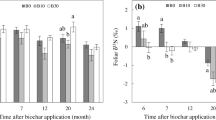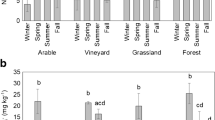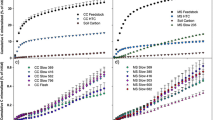Abstract
Purpose
Nitrogen (N) cycle is one of the key biogeochemical cycles in terrestrial ecosystems. Global climate change and soil management practices have disrupted the soil N cycling processes due to increased water and N limitations. Biochar is a soil amendment and improves soil–plant water and N retentions. However, it is uncertain to what extent biochar pyrolysis temperature would affect soil N transformations under two soil moisture regimes. This study aimed to explore how pyrolysis temperature would affect biochar properties and subsequently soil N transformations through a short-term laboratory incubation study at two moisture levels.
Materials and methods
An incubation study was carried out for 5 days. Biochar added to the soil at a rate of 5% (w/w) was produced under six different pyrolysis temperatures (e.g., 500, 600, 650, 700, 750, and 850 °C). We used 15N natural abundance (δ15N) of inorganic N (NH4+-N and NO3−-N) to assess the potential of biochar materials in facilitating forest soil N transformations at two different soil moisture levels of 50% and 65% water holding capacity (WHC).
Results and discussion
Pyrolysis temperature significantly increased cumulative nitrification and N mineralization initially, peaked between 600 and 700 °C and decreased thereafter. However, both cumulative nitrification and N mineralization were significantly lower in the biochar-amended soils than those of the control soil, with significantly lower δ15N of NH4+-N and δ15N of NO3−-N. The 65% WHC had higher cumulative nitrification and N mineralization compared with those in 50% WHC. This study highlights that application of biochar would reduce N losses and improve soil N retention particularly for forest soil.
Conclusions
The present study highlights the importance of biochar pyrolysis temperatures for their use as soil conditioner to increase soil N retention. An optimum pyrolysis temperature range of 600–700 °C was identified for improving soil nitrification and N mineralization under the laboratory incubation conditions.




Similar content being viewed by others
References
Al-Wabel MI, Al-Omran A, El-Naggar AH, Nadeem M, Usman Adel RA (2013) Pyrolysis temperature induced changes in characteristics and chemical composition of biochar produced from conocarpus wastes. Biores Technol 131:374–379
Asadyar L, Xu CY, Wallace HM, Xu Z, Reverchon F, Bai SH (2021) Soil-plant nitrogen isotope composition and nitrogen cycling after biochar applications. Environ Sci Pollut Res 28:6684–6690
Bai SH, Xu CY, Xu Z, Blumfield TJ, Wallace HM, Walton DA, Randal BW, Zwieten LV (2016) Wood base biochar alters inorganic N. In XXIX Int Hortic Congr on Horticulture: Sustaining Lives, Livelihoods and Landscapes (IHC2014):151–154
Bai SH, Xu Z, Blumfield TJ, Reverchon F (2015a) Human footprints in urban forests: implication of nitrogen deposition for nitrogen and carbon storage. J Soils Sediments 15:1927–1936
Bai SH, Reverchon F, Xu CY, Xu Z, Blumfield TJ, Zhao H, Van Zwieten L, Wallace HM (2015b) Wood biochar increases nitrogen retention in field settings mainly through abiotic processes. Soil Biol Biochem 90:232–240
Brown RA, Kercher AK, Nguyen TH, Nagle DC, Ball WP (2006) Production and characterization of synthetic wood chars for use as surrogates for natural sorbents. Org Geochem 37:321–333
Burrell LD, Zehetner F, Rampazzo N, Wimmer B, Soja G (2016) Long-term effects of biochar on soil physical properties. Geoderma 282:96–102
Burton J, Chen C, Xu Z, Ghadiri H (2007) Gross nitrogen transformations in adjacent native and plantation forests of subtropical Australia. Soil Biol Biochem 39:426–433
Chan KY, Xu Z (2009) Biochar: nutrient properties and their enhancement. In: Lehmann J, Joseph S (ed) Biochar for Environmental Management: Science and Technology, 1st edn. Earthscan, London, UK, pp 67–84
Chen CR, Xu Z, Mathers NJ (2004) Soil carbon pools in adjacent natural and plantation forests of subtropical Australia. Soil Sci Soc Am J 68:282–291
Chorover J, Vitousek PM, Everson DA, Esperanza AM, Turner D (1994) Solution chemistry profiles of mixed-conifer forests before and after fire. Biogeochem 26:115–144
Chun Y, Sheng G, Chiou CT, Xing B (2004) Compositions and sorptive properties of crop residue-derived chars. Environ Sci Technol 38:4649–4655
DeLuca TH, Gundale MJ, MacKenzie MD, Jones DL (2015) Biochar effects on soil nutrient transformations. In: Lehmann J, Joseph S (eds) Biochar for Environmental Management: Science, Technology and Implementation, 2nd edn. Taylor & Francis, London and New York, pp 421–454
DeLuca TH, MacKenzie MD, Gundale MJ, Holben WE (2006) Wildfire-produced charcoal directly influences nitrogen cycling in ponderosa pine forests. Soil Sci Soc Am J 70:448–453
Downie A, Crosky A, Munroe O (2009) Physical properties of biochar. In: Lehmann J, Stephen J (ed) Biochar for environmental management: science and technology, 1st edn. Earthscan, London, UK, pp 13–32
Farrar MB, Wallace HM, Xu CY, Joseph S, Dunn PK, Nguyen TTN, Bai SH (2021) Biochar co-applied with organic amendments increased soil-plant potassium and root biomass but not crop yield. J Soils Sediments 21:784–798
Fu L, Xu Y, Xu Z, Wu B, Zhao D (2020) Tree water-use efficiency and growth dynamics in response to climatic and environmental changes in a temperate forest in Beijing, China. Environ Int 134:105209
Gaskin JW, Steiner C, Harris K, Das KC, Bibens B (2008) Effect of low-temperature pyrolysis conditions on biochar for agricultural use. Transactions ASABE 51:2061–2069
Glaser B, Lehmann J, Zech W (2002) Ameliorating physical and chemical properties of highly weathered soils in the tropics with charcoal–a review. Biol Fertil Soils 35:219–230
Guinto DF, Xu Z, House AP, Saffigna PG (2000) Assessment of N2 fixation by understorey acacias in recurrently burnt eucalypt forests of subtropical Australia using 15N isotope dilution techniques. Can J for Res 30:112–121
Gul S, Whalen JK (2016) Biochemical cycling of nitrogen and phosphorus in biochar-amended soils. Soil Biol Biochem 103:1–15
Hallin S, Jones CM, Schloter M, Philippot L (2009) Relationship between N-cycling communities and ecosystem functioning in a 50-year-old fertilization experiment. Int Soc Microb Ecol J 3:597–605
Hannet G, Singh K, Fidelis C, Farrar MB, Muqaddas B, Bai SH (2021) Effects of biochar, compost, and biochar-compost on soil total nitrogen and available phosphorus concentrations in a corn field in Papua New Guinea. Environ Sci Pollut Res 28:27411–27419
Harter J, Guzman-Bustamante I, Kuehfuss S, Ruser R, Well R, Spott O, Kappler A, Behrens S (2016) Gas entrapment and microbial N2O reduction reduce N2O emissions from a biochar-amended sandy clay loam soil. Sci Rep 6:39574
He J, Xu Z, Hughes J (2005) Analyses of soil fungal communities in adjacent natural forest and hoop pine plantation ecosystems of subtropical Australia using molecular approaches based on 18S rRNA genes. FEMS Microbiol Lett 247:91–100
Hietz P, Turner BL, Wanek W, Richter A, Nock CA, Wright SJ (2011) Long-term change in the nitrogen cycle of tropical forests. Science 334:664–666
Kammann CI, Schmidt HP, Messerschmidt N, Linsel S, Steffens D, Müller C, Koyro HW, Conte P, Stephen J (2015) Plant growth improvement mediated by nitrate capture in co-composted biochar. Sci Rep 5:11080
Kaye JP, Hart SC (1998) Ecological restoration alters nitrogen transformations in a ponderosa pine–bunchgrass ecosystem. Ecol Appl 8:1052–1060
Lan Z, Chen C, Rashti MR, Yang H, Zhang D (2018) High pyrolysis temperature biochars reduce nitrogen availability and nitrous oxide emissions from an acid soil. Glob Chang Biol Bioenergy 10:930–945
Lawrinenko M, Laird DA (2013) Anion exchange capacity of biochar. Green Chem 1:1–17
Lehmann J, Gaunt J, Rondon M (2006) Bio-char sequestration in terrestrial ecosystems–a review. Mitig Adapt Strateg Glob Chang 11:395–419
Li L, Zheng Z, Wang W, Biederman JA, Xu X, Ran Q, Qian R, Xu C, Zhang B, Wang F, Zhou S, Cui L, Che R, Hao Y, Cui X, Xu Z, Wang Y (2020) Terrestrial N2O emissions and related functional genes under climate change: a global meta-analysis. Glob Chang Biol 26:931–943
Mizuta K, Matsumoto T, Hatate Y, Nishihara K, Nakanishi T (2004) Removal of nitrate-nitrogen from drinking water using bamboo powder charcoal. Biores Technol 95:255–257
Montano NM, García-Oliva F, Jaramillo VJ (2007) Dissolved organic carbon affects soil microbial activity and nitrogen dynamics in a Mexican tropical deciduous forest. Plant Soil 295:265–277
Mukherjee A, Zimmerman AR, Harris W (2011) Surface chemistry variations among a series of laboratory-produced biochars. Geoderma 163:247–255
Nelissen V, Rütting T, Huygens D, Staelens J, Ruysschaert G, Boeckx P (2012) Maize biochars accelerate short-term soil nitrogen dynamics in a loamy sand soil. Soil Biol Biochem 55:20–27
Nguyen TTN, Xu CY, Tahmasbian I, Che R, Xu Z, Zhou X, Wallace HM, Bai SH (2017) Effects of biochar on soil available inorganic nitrogen: a review and meta-analysis. Geoderma 288:79–96
Nguyen TTN, Wallace HM, Xu CY, Zwieten LV, Weng ZH, Xu Z, Che R, Tahmasbian I, Hu HW, Bai SH (2018) The effects of short term, long term and reapplication of biochar on soil bacteria. Sci Total Environ 636:142–151
Novak JM, Busscher WJ, Watts DW, Laird DA, Ahmedna MA, Niandou MA (2010) Short-term CO2 mineralization after additions of biochar and switchgrass to a Typic Kandiudult. Geoderma 154:281–288
Pörtl K, Zechmeister-Boltenstern S, Wanek W, Ambus P, Berger TW (2007) Natural 15N abundance of soil N pools and N2O reflect the nitrogen dynamics of forest soils. Plant Soil 295:79–94
Prosser JI, Nicol GW (2012) Archaeal and bacterial ammonia-oxidisers in soil: the quest for niche specialisation and differentiation. Trends Microbiol 20:523–531
Pu GX, Saffigna PG, Xu Z (2001) Denitrification, leaching and immobilization of 15N labelled nitrate in winter under windrowed harvesting residues in 1 to 3-year old hoop pine plantation of subtropical Australia. For Ecol Manage 152:183–194
Reverchon F, Flicker RC, Yang H, Yan G, Xu Z, Chen C, Bai SH, Zhang D (2014) Changes in δ15N in a soil–plant system under different biochar feedstocks and application rates. Biol Fertil Soils 50:275–283
Rui YC, Wang SP, Xu Z, Wang YF, Chen CR, Zhou XO, Lu SB, Hu YG (2011) Warming and grazing affect soil labile carbon and nitrogen pools differently in an alpine meadow of the Qinghai-Tibet plateau in China. J Soils Sediments 11:903–914
Shenbagavalli S, Mahimairaja S (2012) Characterization and effect of biochar on nitrogen and carbon dynamics in soil. Int J Adv Biol Res 2:249–255
Singh BP, Hatton BJ, Singh B, Cowie AL, Kathuria A (2010) Influence of biochars on nitrous oxide emission and nitrogen leaching from two contrasting soils. J Environ Qual 39:1224–1235
Song Y, Zhang X, Ma B, Chang SX, Gong J (2014) Biochar addition affected the dynamics of ammonia oxidizers and nitrification in microcosms of a coastal alkaline soil. Biol Fertil Soils 50:321–332
Stark JM, Hart SC (1996) Diffusion technique for preparing salt solutions, Kjeldahl digests, and persulfate digests for nitrogen-15 analysis. Soil Sci Soc Am J 60:1846–1855
Taghizadeh-Toosi A, Clough TJ, Sherlock RR, Condron LM (2012) A wood based low-temperature biochar captures NH3-N generated from ruminant urine-N, retaining its bioavailability. Plant Soil 353:73–84
Thies JE, Rillig MC, Graber ER (2015) Biochar effects on the abundance activity and diversity of the soil biota. In: Lehmann J, Stephen J (eds) Biochar for Environmental Management: Science, Technology and Implementation, 2nd edn. Routledge, New York, pp 327–389
Wang D, Xu Z, Blumfield TJ, Zalucki J (2020) The potential of using 15N natural abundance in changing ammonium-N and nitrate-N pools for studying in situ soil N transformations. J Soils Sediments 20:1323–1331
Wang X, Zhou W, Liang G, Song D, Zhang X (2015a) Characteristics of maize biochar with different pyrolysis temperatures and its effects on organic carbon, nitrogen and enzymatic activities after addition to fluvo-aquic soil. Sci Total Environ 538:137–144
Wang Y, Xu Z, Zheng J, Abdullah KM, Zhou Q (2015b) δ15N of soil nitrogen pools and their dynamics under decomposing leaf litters in a suburban native forest subject to repeated prescribed burning in southeast Queensland, Australia. J Soils Sediments 15:1063–1074
Wang Y, Zhang L, Yang H, Yan G, Xu Z, Chen C, Zhang D (2016) Biochar nutrient availability rather than its water holding capacity governs the growth of both C3 and C4 plants. J Soils Sediments 16:801–810
Xu Z, Saffigna PG, Farquhar GD, Simpson JA, Haines RJ, Walker S, Osborne DO, Guinto D (2000) Carbon isotope discrimination and oxygen isotope composition in clones of the F1 hybrid between slash pine and Caribbean pine in relation to tree growth, water-use efficiency and foliar nutrient concentration. Tree Physiol 20:1209–1217
Xu Z, Ward S, Chen CR, Blumfield T, Prasolova NV, Liu JX (2008) Soil carbon and nutrient pools, microbial properties and gross nitrogen transformations in adjacent natural forest and hoop pine plantations of subtropical Australia. J Soils Sediments 8:99–105
Yao Y, Gao B, Zhang M, Inyang M, Zimmerman AR (2012) Effect of biochar amendment on sorption and leaching of nitrate, ammonium, and phosphate in a sandy soil. Chemosphere 89:1467–1471
Yuan JH, Xu RK, Zhang H (2011) The forms of alkalis in the biochar produced from crop residues at different temperatures. Biores Technol 102:3488–3497
Zhang H, Voroney RP, Price GW (2015) Effects of temperature and processing conditions on biochar chemical properties and their influence on soil C and N transformations. Soil Biol Biochem 83:19–28
Zhang H, Chen C, Gray EM, Boyd SE (2017a) Effect of feedstock and pyrolysis temperature on properties of biochar governing end use efficacy. Biomass Bioenergy 105:136–146
Zhang M, Wang W, Tang L, Heenan M, Xu Z (2018a) Effects of nitrification inhibitor and herbicides on nitrification, nitrite and nitrate consumptions and nitrous oxide emission in an Australian sugarcane soil. Biol Fertil Soils 54:697–706
Zhang M, Wang W, Bai SH, Zhou X, Teng Y, Xu Z (2018b) Antagonistic effects of nitrification inhibitor 3, 4-dimethylpyrazole phosphate and fungicide iprodione on net nitrification in an agricultural soil. Soil Biol Biochem 116:167–170
Zhang Y, Chen H, Bai SH, Menke C, Zhang M, Xu Z (2017b) Interactive effects of biochar addition and elevated carbon dioxide concentration on soil carbon and nitrogen pools in mine spoil. J Soils Sediments 17:2400–2409
Zheng H, Wang Z, Deng X, Zhao J, Luo Y, Novak J, Herbert S, Xing B (2013) Characteristics and nutrient values of biochars produced from giant reed at different temperatures. Biores Technol 130:463–471
Zhu T, Zhang J, Yang W, Cai Z (2012) Effects of organic material amendment and water content on NO, N2O, and N2 emissions in a nitrate-rich vegetable soil. Biol Fertil Soils 49:153–163
Acknowledgements
This publication is based on the PhD research supported by Griffith University International Postgraduate Research Scholarship for AN. We would like to thank M Farrar for providing us with the commercial biochar. We are also thankful to the University of Western Australia (Perth, WA, Australia) for provision of the high temperature biochars. Special thanks are due to Amal Succarie and Dan Xiao for accompanying us at field work.
Author information
Authors and Affiliations
Corresponding author
Additional information
Responsible editor: Caixian Tang
Publisher's Note
Springer Nature remains neutral with regard to jurisdictional claims in published maps and institutional affiliations.
Supplementary Information
Below is the link to the electronic supplementary material.
Rights and permissions
About this article
Cite this article
Nessa, A., Bai, S.H., Wang, D. et al. Soil nitrification and nitrogen mineralization responded non-linearly to the addition of wood biochar produced under different pyrolysis temperatures. J Soils Sediments 21, 3813–3824 (2021). https://doi.org/10.1007/s11368-021-03077-9
Received:
Accepted:
Published:
Issue Date:
DOI: https://doi.org/10.1007/s11368-021-03077-9




